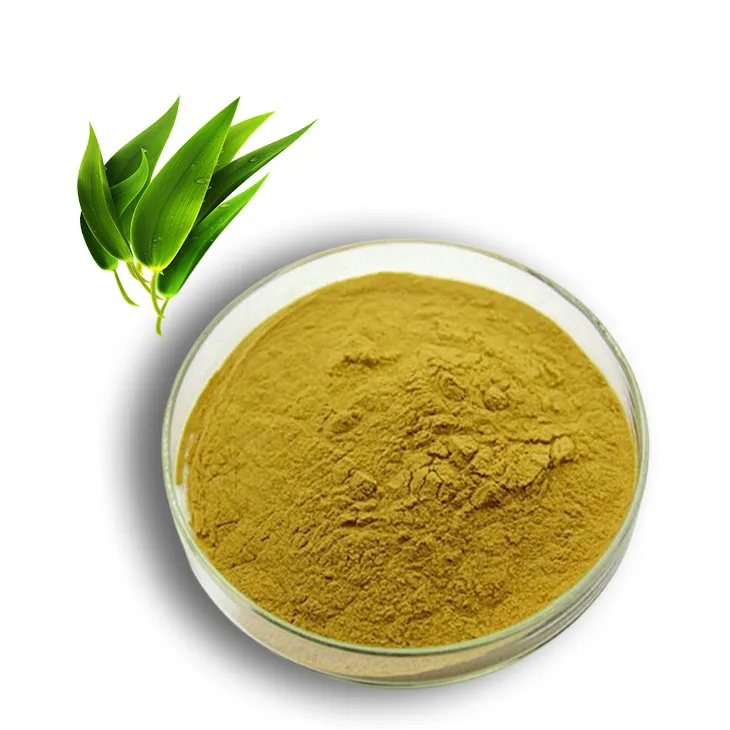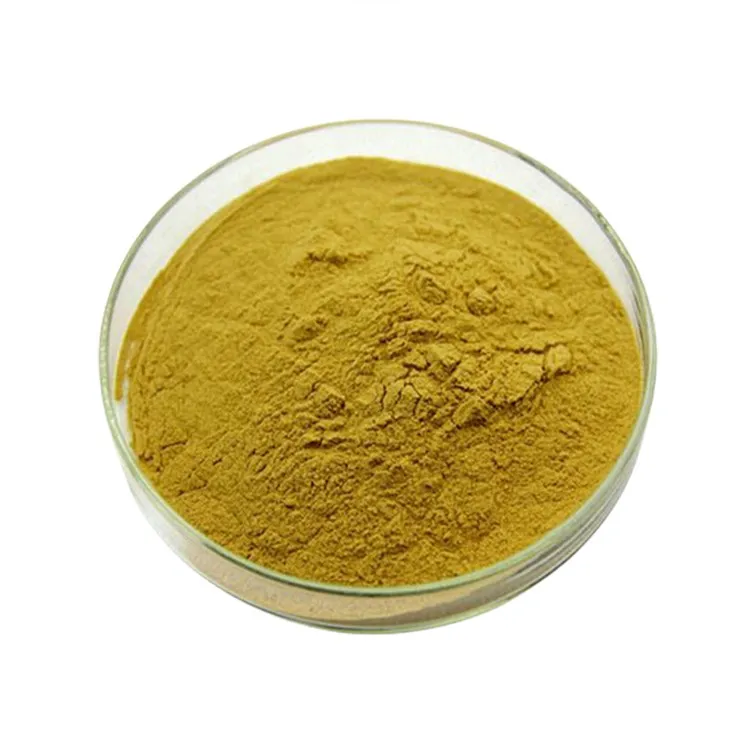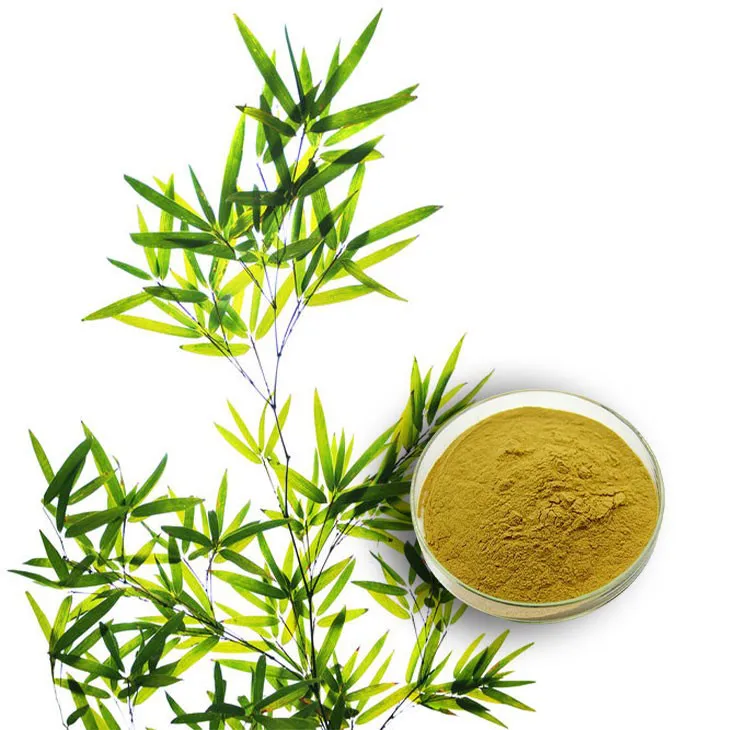- 0086-571-85302990
- sales@greenskybio.com
How to make powder from bamboo leaf extract?
2024-11-30

1. Introduction
Bamboo Leaf extract has been recognized for its numerous potential health benefits, including antioxidant, anti - inflammatory, and antimicrobial properties. Transforming this extract into powder form can enhance its stability, ease of storage, and versatility in various applications such as in the food, pharmaceutical, and cosmetic industries. In this article, we will delve into the process of making powder from Bamboo Leaf extract, covering aspects from the significance of the extract to quality control during the powder - making process.

2. The Significance of Bamboo Leaf extract
Bamboo leaf extract is rich in bioactive compounds. For instance, it contains flavonoids, which are well - known for their antioxidant effects. These flavonoids can help in scavenging free radicals in the body, thereby reducing oxidative stress.
Moreover, it has been studied for its potential anti - inflammatory properties. Inflammation is associated with many chronic diseases, and substances with anti - inflammatory capabilities like bamboo leaf extract may play a role in disease prevention and management.
In the food industry, bamboo leaf extract can be used as a natural preservative due to its antimicrobial activity. This is especially appealing as consumers are increasingly demanding natural alternatives to synthetic preservatives.

3. Equipment Needed for Powder Production
3.1. Evaporator
An evaporator is crucial for removing the solvent from the bamboo leaf extract. There are different types of evaporators available, such as rotary evaporators. Rotary evaporators work by rotating the flask containing the extract under reduced pressure, which causes the solvent to evaporate at a lower temperature. This helps in preserving the bioactive compounds in the extract as they are less likely to be degraded at lower temperatures.
3.2. Spray Dryer
The spray dryer is one of the most common pieces of equipment used to convert the concentrated extract into powder. In a spray dryer, the concentrated extract is sprayed into a hot air stream. As the droplets of the extract come into contact with the hot air, the water in the droplets evaporates rapidly, leaving behind fine powder particles. The key advantage of spray drying is that it can produce powders with a relatively uniform particle size, which is important for properties such as flowability and solubility.
3.3. Freeze Dryer (Optional)
Although not always necessary, a freeze dryer can be used in some cases. Freeze drying involves freezing the bamboo leaf extract first and then subjecting it to a vacuum to remove the ice by sublimation. This method is particularly useful for heat - sensitive extracts as it minimizes the exposure of the extract to high temperatures. However, freeze dryers are generally more expensive and have a longer processing time compared to spray dryers.
3.4. Grinding Equipment
If the powder obtained from the drying process has some lumps or is not of the desired fineness, grinding equipment such as a ball mill or a mortar and pestle can be used. A ball mill works by rotating a cylinder containing grinding balls and the material to be ground. The grinding balls collide with the material, breaking it down into smaller particles. A mortar and pestle can be used for small - scale grinding or for further refining the powder obtained from the ball mill.

4. The Process of Making Powder from Bamboo Leaf Extract
4.1. Extraction
Before making the powder, the bamboo leaves need to be extracted. This typically involves soaking the bamboo leaves in a suitable solvent, such as ethanol or water. The choice of solvent depends on the nature of the bioactive compounds to be extracted. For example, if the target compounds are more soluble in ethanol, ethanol - based extraction may be preferred.
The extraction process can be carried out using various methods, such as maceration, where the leaves are simply soaked in the solvent for a period of time, or Soxhlet extraction, which is a more continuous extraction method. After extraction, the resulting solution contains the bamboo leaf extract along with the solvent.
4.2. Concentration
Once the extract has been obtained, the next step is to concentrate it. This is where the evaporator comes into play. The solvent is removed from the extract, leaving behind a more concentrated form of the bamboo leaf extract. During this process, care must be taken to control the temperature and pressure to avoid degradation of the bioactive compounds. For example, if using a rotary evaporator, the rotation speed, temperature, and vacuum level should be optimized according to the characteristics of the extract.
4.3. Drying
Drying is a critical step in transforming the extract into powder. As mentioned earlier, either a spray dryer or a freeze dryer can be used.
If using a spray dryer, the concentrated extract is first prepared into a suitable form for spraying. This may involve adjusting the viscosity of the extract. The hot air temperature, flow rate, and spray rate are important parameters to control during spray drying. A higher hot air temperature can increase the drying rate but may also lead to some degradation of the bioactive compounds if it is too high.
In the case of freeze drying, the frozen extract is placed in the freeze dryer, and the vacuum and temperature are adjusted according to the manufacturer's instructions. The freeze - drying process is relatively slow but can result in a high - quality powder with good preservation of bioactive compounds.
4.4. Grinding (if necessary)
If the powder obtained from the drying process is not satisfactory in terms of fineness or has lumps, it can be ground using the grinding equipment. The grinding time and intensity should be adjusted based on the desired particle size. For example, if a very fine powder is required, a longer grinding time may be needed with the ball mill.

5. Quality Control during the Process
5.1. Purity of the Extract
Ensuring the purity of the extract is essential. This involves checking for contaminants such as heavy metals, pesticides, and other impurities. Analytical techniques such as atomic absorption spectroscopy can be used to detect heavy metals, while gas chromatography - mass spectrometry can be employed to identify pesticide residues.
The starting material, i.e., the bamboo leaves, should be sourced from reliable suppliers to minimize the risk of contamination. Additionally, during the extraction process, proper cleaning of the equipment and use of high - quality solvents can also contribute to the purity of the extract.
5.2. Bioactive Compound Content
Monitoring the bioactive compound content throughout the process is crucial. High - performance liquid chromatography (HPLC) is a commonly used technique to analyze the content of flavonoids and other bioactive compounds in the bamboo leaf extract. This helps in ensuring that the powder retains its beneficial properties. If the content of bioactive compounds decreases significantly during the powder - making process, it may indicate that the process conditions need to be adjusted, such as reducing the drying temperature or shortening the processing time.
5.3. Particle Size and Powder Properties
Controlling the particle size of the powder is important for its applications. For example, in the food industry, a fine powder with a uniform particle size is desirable for better mixing and dispersion. Particle size analysis can be carried out using techniques such as laser diffraction. Additionally, other powder properties such as flowability and solubility should also be evaluated. A powder with good flowability is easier to handle during processing, and solubility affects its performance in applications such as in making solutions or suspensions.
5.4. Microbiological Quality
Testing for microbiological quality is necessary, especially if the powder is intended for use in the food or pharmaceutical industries. This includes checking for the presence of bacteria, fungi, and other microorganisms. Standard microbiological tests such as total plate count, yeast and mold count, and pathogen detection should be carried out. If the microbiological quality does not meet the required standards, appropriate sterilization or disinfection methods may need to be implemented during the process.
6. Conclusion
Making powder from bamboo leaf extract involves a series of steps from extraction to drying and quality control. The choice of equipment and process parameters plays a crucial role in obtaining a high - quality powder with preserved bioactive compounds. By carefully controlling each step of the process and implementing strict quality control measures, it is possible to produce bamboo leaf extract powder that can be used in various industries, taking advantage of its numerous potential benefits.
FAQ:
Q1: What is the significance of bamboo leaf extract?
Bamboo leaf extract is rich in bioactive compounds such as flavonoids, phenolic acids, and polysaccharides. These components have antioxidant, anti - inflammatory, and antimicrobial properties. It can be used in the food, pharmaceutical, and cosmetic industries, for example, as a natural preservative in food or an ingredient in skincare products for its antioxidant benefits.
Q2: What equipment is necessary for making powder from bamboo leaf extract?
Typically, you will need an evaporator to remove the solvent if there is any in the extract. A spray dryer or freeze dryer is essential for transforming the liquid extract into powder. A grinder may also be required to ensure the powder has a uniform particle size. Additionally, measuring instruments like a balance for accurate weighing of raw materials and finished products are necessary.
Q3: How to ensure quality control during the powder - making process?
Firstly, the quality of the bamboo leaf extract as the raw material should be strictly inspected, including the purity and concentration of active ingredients. During the drying process, parameters such as temperature and drying time in the spray dryer or freeze dryer need to be carefully controlled to avoid over - drying or under - drying which may affect the quality of the powder. Regular sampling and analysis of the powder for properties like particle size distribution, moisture content, and active ingredient content should be carried out.
Q4: Can the powder - making process affect the bioactivity of bamboo leaf extract?
Yes, it can. High temperatures during drying, for example, in a spray dryer, may cause some degradation of heat - sensitive bioactive compounds in the bamboo leaf extract. Therefore, it is crucial to optimize the drying process conditions to minimize the loss of bioactivity. Freeze - drying is a relatively milder method that may better preserve the bioactivity compared to some other drying methods.
Q5: What are the storage requirements for bamboo leaf extract powder?
The powder should be stored in a cool, dry, and dark place. Moisture and high temperature can cause the powder to clump and may also lead to degradation of the active ingredients. It is best to store it in airtight containers to prevent exposure to air and moisture. Also, it should be kept away from strong odors as the powder may absorb them.
Related literature
- Bamboo Leaf Extract: Properties, Applications, and Processing Technologies"
- "Advances in Bamboo Leaf Extract Powder Production: Quality and Efficiency"
- "The Role of Bamboo Leaf Extract in Functional Food and Its Powder - Form Processing"
- ▶ Hesperidin
- ▶ citrus bioflavonoids
- ▶ plant extract
- ▶ lycopene
- ▶ Diosmin
- ▶ Grape seed extract
- ▶ Sea buckthorn Juice Powder
- ▶ Beetroot powder
- ▶ Hops Extract
- ▶ Artichoke Extract
- ▶ Reishi mushroom extract
- ▶ Astaxanthin
- ▶ Green Tea Extract
- ▶ Curcumin Extract
- ▶ Horse Chestnut Extract
- ▶ Other Problems
- ▶ Boswellia Serrata Extract
- ▶ Resveratrol Extract
- ▶ Marigold Extract
- ▶ Grape Leaf Extract
- ▶ blog3
- ▶ blog4
-
The best organic aged garlic extract.
2024-11-30
-
Konjac flour manufacturers from China.
2024-11-30
-
Certified organic comfrey extract.
2024-11-30
-
The best sophora japonica extract in 2024.
2024-11-30
-
Black Rice Extract Manufacturers from China.
2024-11-30
-
Nature's Bounty Rhodiola Root Extract.
2024-11-30
-
Peppermint oil manufacturers from China.
2024-11-30
-
The Best Boswellia Serrata Extract in 2024.
2024-11-30
-
The Best Curcumin in 2024.
2024-11-30
-
White mustard seed extract
2024-11-30
-
Red Wine Extract
2024-11-30
-
Buckthorn bark extract
2024-11-30
-
Thunder God Vine Extract
2024-11-30
-
Golden Seal Extract
2024-11-30
-
White Willow Bark Extract
2024-11-30
-
Selenium yeast
2024-11-30
-
Tamarind extract powder
2024-11-30
-
Green coffee bean Extract
2024-11-30
-
Almond Extract Powder
2024-11-30





















